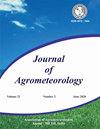未充分利用的热带块茎作物的未来气候适应性——印度的“小行星”
Q3 Agricultural and Biological Sciences
引用次数: 0
摘要
象脚山药和芋头是两种重要的热带块茎作物,在气候变化和粮食安全的背景下被认为是未充分利用的。本研究的重点是量化两种代表性浓度路径(RCP 4.5和RCP 8.5)在2030、2050和2070未来气候情景下的未来气候适宜性。利用MaxEnt对印度各地象脚山药和芋头的未来气候适宜性进行了量化。与热带块根作物相比,芋头和象脚山药的气候适宜面积分别增加了49%和46%。在印度,共有218个地区被确定为非常适合种植象脚山药。据观察,印度共有209个地区非常适合种植这两个rcp的芋头。有关地区一级适宜性的信息可以帮助决策者了解在粮食安全背景下印度水稻的气候适宜性可能发生的变化,因为与其他主要粮食作物相比,水稻具有更高的生产力。本文章由计算机程序翻译,如有差异,请以英文原文为准。
Future climate suitability of underutilized tropical tuber crops-‘Aroids’ in India
Elephant foot yam and taro are the two important aroids of tropical tuber crops, considered as underutilized in the context of climate change and food security. The present study focused to quantify the future climate suitability of aroids for future climate scenarios 2030, 2050, and 2070 for the two representative concentration pathways (RCP 4.5 and RCP 8.5). The district-wise future climate suitability of elephant foot yam and taro using MaxEnt across India was quantified. The percentage increase in climatically suitable area for taro is 49% and the same for elephant foot yam is 46% which is higher compared to those of tropical root crops. A total of 218 districts were identified as highly suitable for the cultivation of elephant foot yam for different RCPs across India. A total of 209 districts were observed as highly suitable for taro cultivation across India for the two RCPs. The information about the districtlevel suitability can assist decision-makers to understand the possible shifts in the climate suitability of aroids in India in the context of food security as they have higher productivity compared to other major food grain crops.
求助全文
通过发布文献求助,成功后即可免费获取论文全文。
去求助
来源期刊

Journal of Agrometeorology
农林科学-农艺学
CiteScore
1.40
自引率
0.00%
发文量
95
审稿时长
>12 weeks
期刊介绍:
The Journal of Agrometeorology (ISSN 0972-1665) , is a quarterly publication of Association of Agrometeorologists appearing in March, June, September and December. Since its beginning in 1999 till 2016, it was a half yearly publication appearing in June and December. In addition to regular issues, Association also brings out the special issues of the journal covering selected papers presented in seminar symposia organized by the Association.
 求助内容:
求助内容: 应助结果提醒方式:
应助结果提醒方式:


